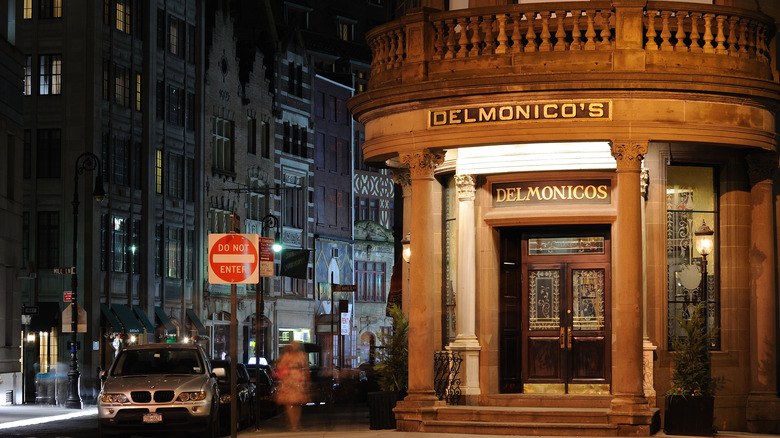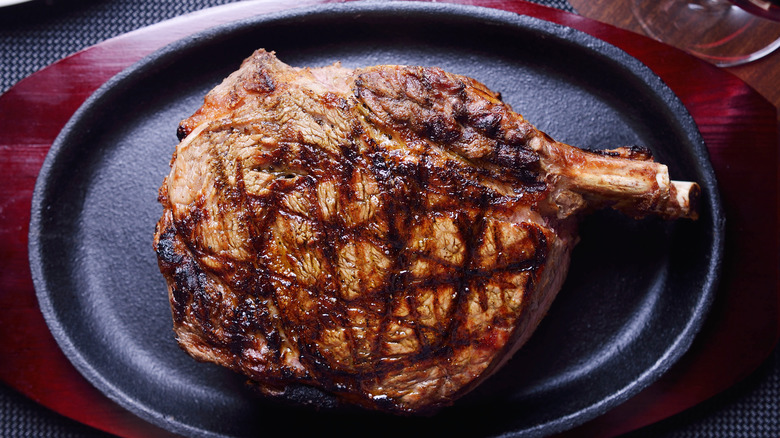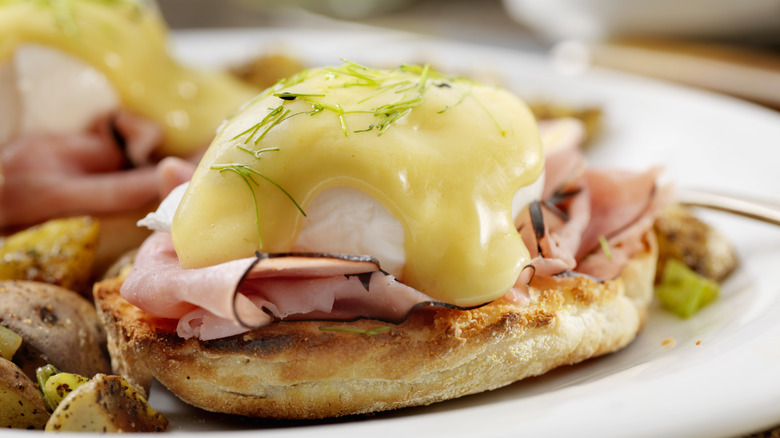How Delmonico's Steakhouse Shaped American Fine Dining
When was fine dining born in the United States? There's a good chance it was in 1837, when famed New York City restaurant Delmonico's opened on Beaver and William Streets in the Financial District. The restaurant itself claims to be the country's "first fine dining establishment," but more importantly, other writers and experts have agreed with this description of the famed steakhouse, which is still open today. Some even describe it as New York's first restaurant, because prior to its arrival, the city's options for eating out were predominantly coffee houses and taverns with no real menu or choice for dinners (although they did serve food, so it really comes down to how you define a restaurant — but the idea was that Delmonico's was the first place with an à la carte menu).
In any case, Delmonico's was a huge departure from whatever constituted New York's food scene at the time. Above all, it offered luxury in the form of things like a private dining room and a huge wine cellar, and was generally lavish with its dining room settings of tablecloths, flowers, and leather chairs. It was a taste of Paris on the other side of the Atlantic, offering up French recipes and novel ingredients like eggplant and artichoke, a shift from the British-inspired food that dominated at the time.
Where did Delmonico's come from?
Like much of New York, Delmonico's was a product of immigration. It was opened by the Delmonico brothers, a Swiss pair, one of whom (John) operated a wine shop in New York, and Peter, who was a successful pastry- and candy-maker in Switzerland. With substantial savings, they opened a cafe-patisserie in 1827 with a focus on European specialties. A success, it expanded into a dining room in 1930 staffed by French chefs — although it wasn't named Delmonico's, this could be seen as the restaurant's founding (or at least a precursor to it). Over the 1830s, the brothers' nephew Lorenzo migrated to New York to help them (he later built Delmonico's up to its iconic status) and the brothers bought a farm in Williamsburg, Brooklyn (then a village) to supply the restaurant.
Finally, in 1837, the restaurant Delmonico's opened at its William Street location, a monumental, three-level palace. Under Lorenzo's management, Delmonico's opened up in other locations in lower Manhattan, luring members of the city's high society.
Delmonico's still exists today as a fine dining spot, but it's not directly connected to the Delmonico family — it was handed down by Lorenzo to other family members before being sold in 1919, and closed in 1923 under Prohibition. Italian immigrant Oscar Tucci bought and revived it later that decade, and his family ran it for much of the century. Grandson Max continues to have a hand in the restaurant, although the restaurant ownership has changed.
Delmonico's famed food
Delmonico's was notable for various reasons — its luxury, being the first place to offer à la carte menus — but arguably the most important thing was what was on those menus. The restaurant was a serious innovator: Around 1840, the Delmonico steak arrived on the scene, a two-inch-thick rib steak (although there's debate about whether it should be prepared bone-in or not) that's still on the menu at the present-day Delmonico's. It was served with herb butter and a baked-then-mashed cheesy potato side.
The restaurant's star continued to ascend from 1862, when French chef Charles Ranhofer took the reins in the kitchen for over three decades. Ranhofer became famed for his creations in the Delmonico's kitchen: He's credited with creating dishes like eggs Benedict and creamy chicken à la king. Sherry-laced, buttery lobster Newberg is also believed to be a Ranhofer creation; many of these dishes feature in Ranhofer's hefty cookbook "The Epicurean" which features some 3,500 recipes. There are also hard-to-verify claims that Ranhofer introduced the avocado to New Yorkers in the late 1800s, and he may have invented Baked Alaska (although there's evidence it existed under a different name beforehand). The innovations didn't stop after Ranhofer's departure — later Delmonico's owner Oscar Tucci is credited with inventing the wedge salad (although it's yet another dish with a contested history).


